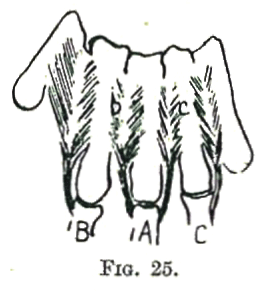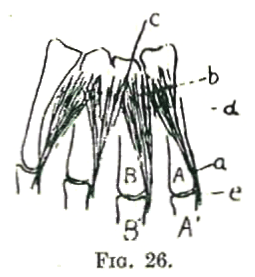Lateral Finger-Movement
When finger-movement is mentioned, we normally think of it as taking place in a vertical plane, which is the typical down and up vertical motion of the finger. Observation is rarely given to the effect of a finger stroke on the lateral movement of an adjoining fingers.
On the other hand, it is this lateral action and reaction that gives us the approach to a study of the muscular adjustment needed in the hand for a single finger-stroke. The location of the muscles in the palm of the hand, and the lines of pull of their tendinous attachments, make necessary a direct interaction of adjoining fingers. A diagrammatic illustration of this arrangement is given in Fig. 26.
A, Ai represents the meta-carpal and first phalanx of the index finger, left-hand, seen from the palmar side.
This makes
This effect is always present in a free finger-stroke of an untrained hand .
This makes
e the hand-knuckle articulat ion. B, B' show a simi'ar part of the third finger; c and d the location of the muscles and their coherence. A pull on a will thus affect b, and when a contracts to move Ai, b is affected and tends to move B toward A.
This effect is always present in a free finger-stroke of an untrained hand .


- What effect does finger stroke have on the lateral movement of adjoining fingers?
- It is the lateral action and reaction that gives us the approach to a study of the muscular adjustment needed in the hand for a single finger-stroke.
- The location of the muscles in the palm of the hand and the lines of pull of their tendinous attachments make necessary a direct interaction of adjoining fingers.
- A, A' represents the meta-carpal and first phalanx of the index finger, seen from the palmar [1] side.
- A stroke of the third finger was used and was recorded on the kymograph by means of a pneumatic tambour.
- The line for the second finger recorded the actual finger movement laterally and any deflection toward the other lime means that the second finger actually moved toward the third of the playing finger.
- Wherever the third finger plays as a result of the muscular pulled toward it because the deflections in the two lines coincide.
- This coordination may be observed by watching an untrained pupil play. Lateral finger shifts occur with the playing of a diatonic passage.
- When the reaction is eliminated or when the finger stroke is isolated, the muscular adjustment ist more complex.
- This is what happens when we try to isolate the finger stroke. In order to neutralize the deflection of the unused (index) toward the used (third) finger, the muscle on the other side of the index finger (thumb side) must be contracted.
- What is apparently a finger stroke is a very complex adjustment of hand muscles, made necessary by the principle of coordination.
- Other muscles than those actually moving must operate to fix the necessary fulcra.
- A similar condition exists among the dorsal interossei.
- These are bipenniform[2] muscles arising from two heads an adjacent sides of the carpal bones.
- A part of the body is not necessarily in a state of relaxation or passivity because it is motionless.
- Unless it is resting upon some outside body, or is in another form of stable equilibrium, it is never relaxed.
[1]palmar adj. [l palmaris] of in, or corresponding to the palm of the hand
[2]
bipenniform: doubly feather-shaped; said of muscles whose fibers are arranged on each side of a tendon like barbs on a feather shaft.